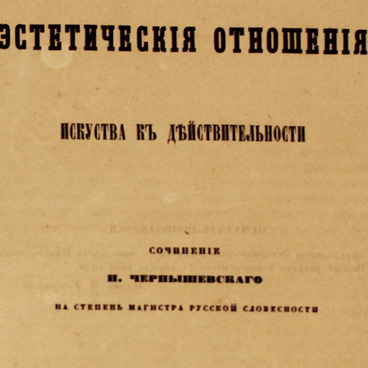The picture of the Saratov High School for Boys was taken by Dmitry Finogeyev, a photographer renowned for his landscapes and city views. He had started his career in a photo studio in Nemetskaya Street, getting a photographer’s license from the authorities of the Saratov province. Later, he moved away to live in the town of Volsk and returned to Saratov in 1887.
In 1889, Dmitry Finogeyev was honorably mentioned at the All-Russian Photography Exhibition in Moscow and received a commendation from the Imperial Russian Technical Society in St. Petersburg. He opened his photo studio in Saratov.
Contemporary commentators noted Finogeyev’s gift for rendering cityscapes remarkably expressive. His compositions are clear and instantly readable. Static views are livened up with staffage: typically, with the image of a horse and cart with driver.
D. Finogeyev’s photograph exhibited here shows the 1st High School for Boys in Gimnazicheskaya Street (currently, Nekrasov Street) in Saratov. The two-storey building is adorned with a pediment and columns. An entrance porch to the left of the central portico is decorated with carved wood.
In 1851-1853, Nikolai Chernyshevsky worked as a teacher in this High School. Graduating from St. Petersburg University with a degree in Russian in 1851, he followed the recommendation of his parents and applied for a position of senior teacher of Russian. In April 1851, he returned to his native Saratov and started working as a teacher with the official rank of titular counsellor (government clerk of the 9th class out of 14).
At first, Chernyshevsky’s pale face, his quiet squeaky voice and myopic eyes, his awkward, heavy-stepping figure with round shoulders seemed comical to the young students. But very soon they came to love the new teacher. ‘What struck us most was his lively expressive speech and also his respect for each of us as an individual, ” a former student recalled.
In a letter to his university friend Mikhail Mikhailov dated May 28th, 1851, Chernyshevsky wrote: “In Saratov, I have found a city even less cultured than your Nizhny [Novgorod]. . Some of the students are fairly developed. I will do my best to encourage their development further. The teachers, though, make you want to laugh and cry…”
In 1889, Dmitry Finogeyev was honorably mentioned at the All-Russian Photography Exhibition in Moscow and received a commendation from the Imperial Russian Technical Society in St. Petersburg. He opened his photo studio in Saratov.
Contemporary commentators noted Finogeyev’s gift for rendering cityscapes remarkably expressive. His compositions are clear and instantly readable. Static views are livened up with staffage: typically, with the image of a horse and cart with driver.
D. Finogeyev’s photograph exhibited here shows the 1st High School for Boys in Gimnazicheskaya Street (currently, Nekrasov Street) in Saratov. The two-storey building is adorned with a pediment and columns. An entrance porch to the left of the central portico is decorated with carved wood.
In 1851-1853, Nikolai Chernyshevsky worked as a teacher in this High School. Graduating from St. Petersburg University with a degree in Russian in 1851, he followed the recommendation of his parents and applied for a position of senior teacher of Russian. In April 1851, he returned to his native Saratov and started working as a teacher with the official rank of titular counsellor (government clerk of the 9th class out of 14).
At first, Chernyshevsky’s pale face, his quiet squeaky voice and myopic eyes, his awkward, heavy-stepping figure with round shoulders seemed comical to the young students. But very soon they came to love the new teacher. ‘What struck us most was his lively expressive speech and also his respect for each of us as an individual, ” a former student recalled.
In a letter to his university friend Mikhail Mikhailov dated May 28th, 1851, Chernyshevsky wrote: “In Saratov, I have found a city even less cultured than your Nizhny [Novgorod]. . Some of the students are fairly developed. I will do my best to encourage their development further. The teachers, though, make you want to laugh and cry…”

